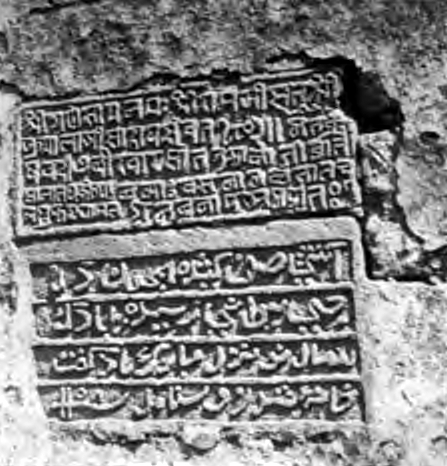Punjabi inscription on the Atashgah beginning with Ik Onkar Satnam"
Bani of Guru Nanak from Sri Guru Granth Sahib Ji
The Sanskrit equivalents for the Panjabi appellations used above are Sat, NAman, Karatd, Purusha, Nirbhaya, Nirvdira, Akalamfirti, Ajanma Svayambhu.
https://ia801702.us.archive.org/15/items/jstor-592636/592636.pdf
Indian Inscriptions on the Fire Temple at Bāku by Justin E. Abbott, 1908
 An inscription from the Baku Atashgah. The first line begins: I salute Lord Ganesha (श्री गणेसाय नम) venerating Hindu god Ganesha, the second venerates the holy fire (जवालाजी, Jwala Ji) and dates the inscription to Samvat 1802 (संवत १८०२, or 1745-46 CE). The Persian quatrain below is the sole Persian inscription on the temple[7] and, though ungrammatical,[7] also refers to the fire (آتش) and dates it to 1158 (١١٥٨) Hijri, which is also 1745 CE.
An inscription from the Baku Atashgah. The first line begins: I salute Lord Ganesha (श्री गणेसाय नम) venerating Hindu god Ganesha, the second venerates the holy fire (जवालाजी, Jwala Ji) and dates the inscription to Samvat 1802 (संवत १८०२, or 1745-46 CE). The Persian quatrain below is the sole Persian inscription on the temple[7] and, though ungrammatical,[7] also refers to the fire (آتش) and dates it to 1158 (١١٥٨) Hijri, which is also 1745 CE. Samskrtam invocation to Lord Shiva in an Atashgah inscription, with the Hindu devotional-form of the Swastika on top
Samskrtam invocation to Lord Shiva in an Atashgah inscription, with the Hindu devotional-form of the Swastika on top
Illustration from Brockhaus and Efron Encyclopedic Dictionary (1890—1907)

Drawing from the book: "Journey in Dagestan and the Caucasus"
Guebre ceremony in Ateshgah temple
Ateshgah, beginning of 20th cent.

Ateshgah fire temple.
http://ateshgahtemple.az/index.php
[quote]The BakuAteshgah (from Persian: آتشگاه, Atashgāh, Azerbaijani: Atəşgah), often called the "Fire Temple of Baku" is a castle-like religious temple in Surakhani,[2] a suburb in Baku, Azerbaijan. Based on Persian and Indian inscriptions, temple was used as a Hindu and Zoroastrian place of worship. "Atash" (آتش) is the Persian word for fire.[3] The pentagonal complex, which has a courtyard surrounded by cells for monks and a tetrapillar-altar in the middle, was built during the 17th and 18th centuries. It was abandoned after 1883[citation needed] when oil and gas plants were established in the vicinity, ending the flow of natural gas to the temple and extinguishing the holy fire.
The Baku Ateshgah was a pilgrimage and philosophical centre of Zoroastrians from Northwestern Indian Subcontinent, who were involved in trade with the Caspian area via the famous "Grand Trunk Road". The four holy elements of their belief were: ateshi (fire), badi (air), abi (water), and heki (earth). The temple ceased to be a place of worship after 1883 with the installation of petroleum plants (industry) at Surakhany. The complex was turned into a museum in 1975. [unquote] https://en.wikipedia.org/wiki/Ateshgah_of_Baku